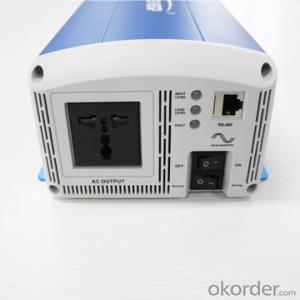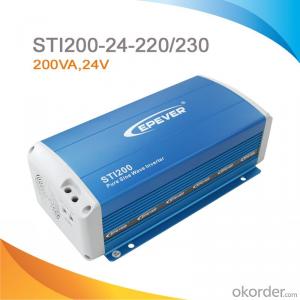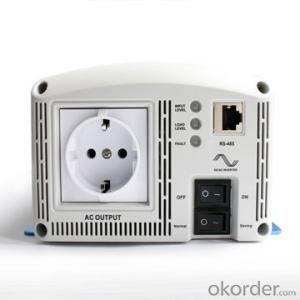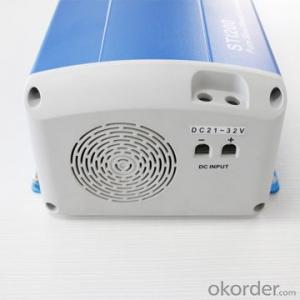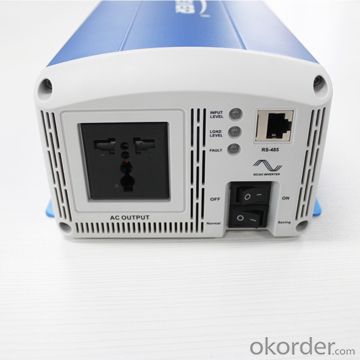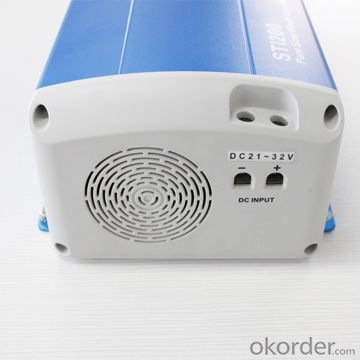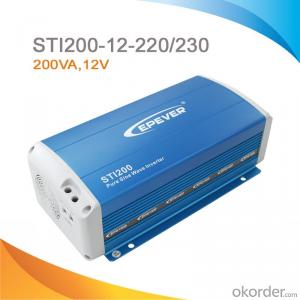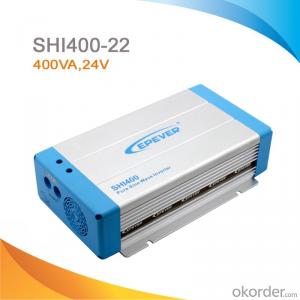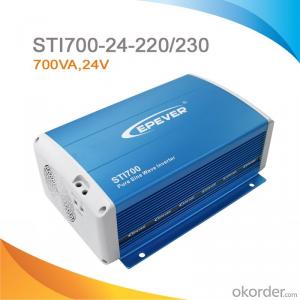Off-Grid Pure Sine Wave Solar Inverter 200W, DC 24V to AC 220/230V,STI200
- Loading Port:
- China Main Port
- Payment Terms:
- TT or LC
- Min Order Qty:
- -
- Supply Capability:
- -
OKorder Service Pledge
OKorder Financial Service
You Might Also Like
Description
STI series is a sine wave power frequency inverter which can convert 12V or 24V DC to 220VAC or 230VAC 50Hz based on full digital and intelligent design. The inverter can be applied in many fields especially for solar photovoltaic power system.
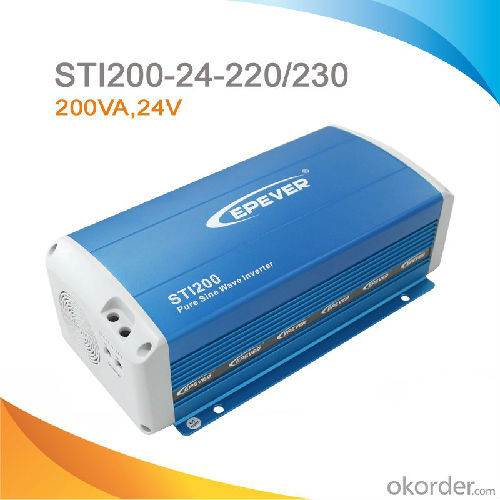
Features:
·Complete isolation-type inverter technology, noiseless output
·Adoption of advanced SPWM technology, pure sine wave output
·Dynamic current loop control technology to ensure inverter reliable operation.
·Wide DC input voltage range
·Excellent EMC design
·Low output harmonic distortion(THD≤3%)
·LED indicators display input voltage range, load power range, normal output & failure state
·Optional energy saving mode
·Wide working temperature range (industrial level)
·Continuous operation at full power
Protections:
·Output Short Circuit protection
·Overload protection
·Input reverse polarity protection
·Input low voltage protection
·Input over voltage protection
·Inverter abnormal protection
·Overheating protection
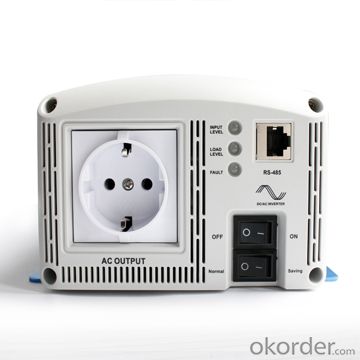
Specification:
Model | STI200-12-220 | STI200-24-220 | |
STI200-12-230 | STI200-24-230 | ||
Nominal battery voltage | 12V | 24V | |
Input voltage range | 10.5~16V | 21~32V | |
Consumption no load(ON) | ≤4W | ≤5W | |
Consumption no load (Saving) | ≤2W | ≤2W | |
Output voltage | AC220/230V±3% | ||
Continuous power | 200VA | ||
Power 10sec | 300VA | ||
Power 1.5sec | 400VA | ||
Surge power | 640VA | ||
Output mode | Single Phase | ||
Wave form | Pure Sine Wave | ||
Frequency | 50Hz±0.2% | ||
Distortion THD ( resistive load) | ≤ 3% | ≤ 2% | |
Efficiency at rated power | ≥81% | ≥85% | |
Max. efficiency | ≥88% | ≥89% | |
Dimension | 315*166*101mm | ||
Net weight | 4.5kg | ||
Working temperature | -20℃~ +50℃ | ||
Humidity | < 95%(non-condensation) | ||
Altitude | < 5000m(Derating to operate according to IEC62040 at a height exceeding 1000 m) | ||
FAQ
Can a solar powered LED lighting without inverter?
Of course you can run lights without inverters. Both LEDs and incandescent lamps are quite happy on DC. And there are fluorescent ballasts that take a DC input (although they do have a sort of inverter inside). I have one in my shed and it has been working just fine for at least 15 years. It is very simple, easy and efficient. You can do away with the electrical code for wiring, lower you cost. Use less energy and lower the cost to install. In fact is we did this to power may of our day to day items we would also lower the demand for power.
Keep in mind this goes against every manufacturer and government policy and you will be shut down, squashed and run out of town for even talking about this, or at least you used to. I am working on a way to use the current wiring in a home to have direct solar, batter bank lighting. By coming off the grid for your lighting and many other functions, a power outage would hardly make a difference to your home.
Does inverter long warranty mean high quality?
SMA did bump up the warranty to 10 years when CSI demanded all inverter manufacturers to do so. The European Sunny Boys are only warrantied for 5 years.
iPhones only have a one year warranty. Does that mean Apple products aren't reliable? Enphase offers a 25 year warranty on their inverters but only one year on their monitoring. Does this mean their monitoring is not as reliable as their inverter? Of course not.
Offering long warranties have very real costs, especially for publicly traded companies like SMA. If we were to offer a 25 year warranty, we would have to hold a higher reserve on our balance sheet, making our products more expensive. We think that our customers would rather have our high quality products at a lower cost.
Start-ups invariably offer long warranties to make up for lack of track record or the perception of quality problems. As the unfortunate recent events at Solyndra have shown, long warranties offered by start-ups can have limited practical value.
Analogies can be drawn to the wind industry: in the early days, customers requested very long warranties (20 years or so), since it was the wild west and no one had a clue about long term O&M requirements for these big new turbines. Now that the wind industry has matured, turbine warranties are again very short (2 years is typical) since the large suppliers have a track record of shipping quality product that does not fail when properly maintained. You could say that PV today is like the wild west environment in wind 10 years ago.
- Q: What is the function of a solar inverter?
- The function of a solar inverter is to convert the direct current (DC) electricity generated by solar panels into alternating current (AC) electricity that can be used to power household appliances and feed into the electrical grid.
- Q: PV grid-connected inverter can directly load it?
- Grid-connected inverter is usually equipped with island protection function, can only receive the power grid, if the load directly, the output is disconnected.
- Q: How does a solar inverter handle variations in grid voltage?
- A solar inverter handles variations in grid voltage by continuously monitoring the grid voltage and adjusting its own output voltage accordingly. It uses advanced control algorithms to maintain a stable and consistent output voltage despite fluctuations in the grid voltage. This ensures that the solar power generated is synchronized with the grid and can be seamlessly fed into the electrical system.
- Q: What is the role of a solar inverter in a community solar project?
- The role of a solar inverter in a community solar project is to convert the direct current (DC) electricity produced by solar panels into alternating current (AC) electricity that can be used by homes and businesses in the community. It ensures that the solar energy generated is compatible with the existing electrical grid, allowing for seamless integration and distribution of clean energy to the community.
- Q: Can a solar inverter be used with a hybrid solar power system?
- Yes, a solar inverter can be used with a hybrid solar power system. A hybrid solar power system typically consists of both solar panels and a secondary power source, such as batteries or a diesel generator. The solar inverter converts the direct current (DC) power generated by the solar panels into alternating current (AC) power that can be used to power appliances and devices in the home or business. Additionally, the solar inverter can also manage the flow of power between the solar panels, the batteries, and the grid, optimizing energy usage and ensuring a reliable power supply.
- Q: How does a solar inverter interact with a battery storage system?
- A solar inverter interacts with a battery storage system by converting the direct current (DC) electricity produced by solar panels into alternating current (AC) electricity, which is then used to charge the batteries. The inverter also ensures that the power from the batteries can be used to supply electricity to the loads when there is no sunlight or during a power outage. Additionally, the inverter manages the flow of electricity between the solar panels, battery, and the electrical grid, optimizing the system's overall efficiency.
- Q: Are all solar inverters compatible with all solar panels?
- No, not all solar inverters are compatible with all solar panels. The compatibility between solar inverters and panels depends on various factors such as the voltage, current, and type of panels being used, as well as the specifications and requirements of the specific inverter model. It is important to ensure that the inverter is compatible with the specific type and configuration of solar panels being installed to ensure optimal performance and efficiency.
- Q: Can a solar inverter be used in areas with limited roof space or installation options?
- Yes, a solar inverter can be used in areas with limited roof space or installation options. Solar inverters are flexible and can be installed in various locations such as walls, ground mounts, or even on poles, allowing for more flexibility in terms of space and installation options. Additionally, there are also compact and space-saving solar inverters available that can be used in areas with limited roof space.
- Q: What is the role of a solar inverter in a grid-independent system?
- The role of a solar inverter in a grid-independent system is to convert the direct current (DC) electricity generated by solar panels into alternating current (AC) electricity that can be used to power household appliances and other electrical devices. It also regulates the voltage and frequency of the electricity to ensure compatibility with the electrical grid. In a grid-independent system, the solar inverter allows for the utilization of solar power without relying on the traditional power grid, enabling self-sufficiency and reducing dependence on fossil fuels.
- Q: Are there any voltage or frequency regulations for solar inverters?
- Yes, there are voltage and frequency regulations for solar inverters. These regulations vary by country and are typically established by regulatory bodies or standards organizations. They ensure that the output voltage and frequency of solar inverters meet the required standards to ensure grid compatibility and prevent any potential damage to the electrical infrastructure.
Send your message to us
Off-Grid Pure Sine Wave Solar Inverter 200W, DC 24V to AC 220/230V,STI200
- Loading Port:
- China Main Port
- Payment Terms:
- TT or LC
- Min Order Qty:
- -
- Supply Capability:
- -
OKorder Service Pledge
OKorder Financial Service
Similar products
Hot products
Hot Searches
Related keywords
